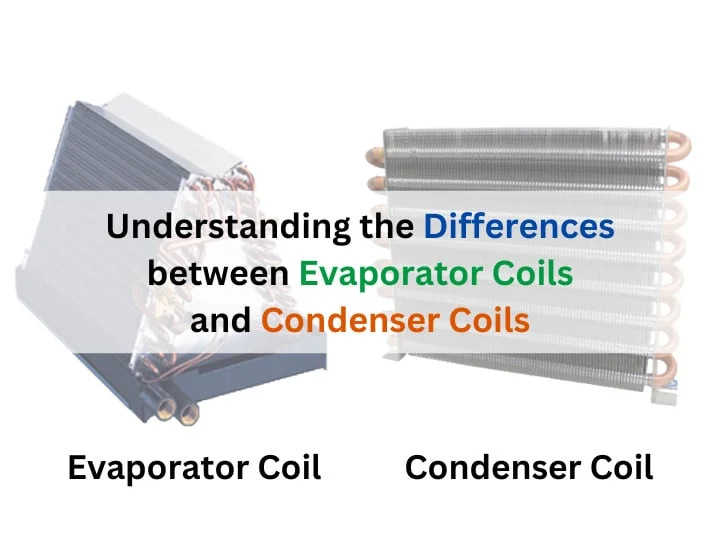Air conditioning systems consist of a variety of components, including the AC condenser coil and evaporator coil, which work together to regulate the temperature and humidity of indoor air.
While both the condenser and evaporator coils are important parts of an air conditioning system, they serve very different purposes and have unique characteristics that set them apart. Let’s take a closer look at the difference between evaporator coils and condenser coils, and how they work together to regulate indoor temperature.

What is an AC Condenser Coil?
The AC condenser coil is a key component of the air conditioning system located outdoors, usually on the roof or on a platform near the ground. Its primary function is to release heat absorbed by the refrigerant as it circulates through the system.
The condenser coil is made up of thin metal fins that dissipate the heat into the air. It is responsible for converting the refrigerant from a hot, high-pressure gas into a cooler, low-pressure liquid. To do this, the refrigerant passes through the condenser coil, where the heat is released to the outside air.
The condenser coil is an important part of the air conditioning process because it helps to lower the temperature of the refrigerant, which makes it more effective at absorbing heat from the indoor air. The heat that is released by the condenser coil is typically dissipated into the air through the use of a fan or blower.
The AC condenser coil is a key component of the air conditioning system located outdoors, usually on the roof or on a platform near the ground. Its primary function is to release heat absorbed by the refrigerant as it circulates through the system.
The condenser coil is made up of thin metal fins that dissipate the heat into the air. It is responsible for converting the refrigerant from a hot, high-pressure gas into a cooler, low-pressure liquid. To do this, the refrigerant passes through the condenser coil, where the heat is released to the outside air.
The condenser coil is an important part of the air conditioning process because it helps to lower the temperature of the refrigerant, which makes it more effective at absorbing heat from the indoor air. The heat that is released by the condenser coil is typically dissipated into the air through the use of a fan or blower.

What is an Evaporator Coil?
The evaporator coil is another crucial component of an air conditioning system that is located inside the building, usually in the air handler or furnace. Its primary function is to absorb heat from the indoor air as it passes over the coil.
Like the condenser coil, the evaporator coil is made up of thin metal fins that help transfer the heat from the air to the refrigerant. It is responsible for converting the refrigerant from a cool, low-pressure liquid into a hot, high-pressure gas. As the refrigerant absorbs heat from the indoor air, it vaporizes and becomes a gas, which is then circulated back to the condenser coil to be cooled once again.

The evaporator coil plays a vital role in the air conditioning process, lowering the temperature of indoor air as it passes over the coil, keeping the space comfortable and cool.
Evaporator Coil vs. Condenser Coil: Key Differences
Now that we’ve looked at the basic functions of the evaporator and condenser coils, let’s take a closer look at the key differences between these two components:
- Location: As mentioned, the condenser coil is located outside the building, while the evaporator coil is located inside.
- The direction of Heat Transfer: The main difference between the evaporator and condenser coils is the direction in which they transfer heat. The condenser coil releases heat to the outside air, while the evaporator coil absorbs heat from the indoor air.
- Type of Refrigerant: Another key difference between the two coils is the type of refrigerant they use. The condenser coil uses a high-pressure refrigerant, while the evaporator coil uses a low-pressure refrigerant.
- Purpose: While both the evaporator and condenser coils are important parts of an air conditioning system, they serve different purposes. The condenser coil is responsible for releasing heat and converting the refrigerant into a low-pressure
Benefits and Need for AC condenser and Evaporator Coil
The system would not regulate the temperature and humidity of the indoor air without the use of these vital components.
It is not accurate to say that one of these coils is more effective or beneficial than the other. Both the condenser and evaporator coils serve different functions, and they work together to ensure that the air conditioning system is operating efficiently.
The condenser coil is responsible for releasing the heat absorbed by the refrigerant as it circulates through the system, while the evaporator coil is responsible for absorbing heat from the indoor air.
Without the condenser coil, the system would not be able to release the heat that it absorbs, and the refrigerant would not be able to cool down. Similarly, without the evaporator coil, the system would not be able to absorb heat from the indoor air, and the space would not be cooled.
Let’s just say, your AC unit is incomplete without either.
Conclusion
To understand the difference between AC condenser coils and evaporator coils, you are already armed with the knowledge of how AC units function. The head exchange is primarily and solely done through these core components.
However, through this blog, you may be informed on how to act when your repairman mentions issues with either of these components.




